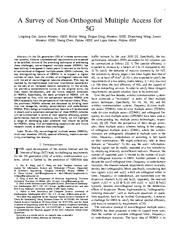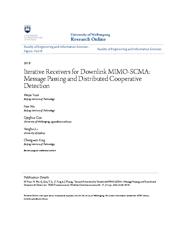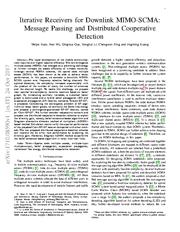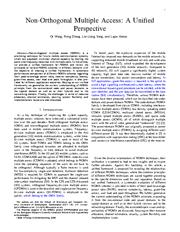A copy of this work was available on the public web and has been preserved in the Wayback Machine. The capture dates from 2018; you can also visit the original URL.
The file type is application/pdf.
Filters
Low Complexity Multi-User MIMO Detection for Uplink SCMA System Using Expectation Propagation Algorithm
2018
TELKOMNIKA (Telecommunication Computing Electronics and Control)
In this paper, we propose a low complexity detector algorithm named the expectation propagation algorithm (EPA) for SCMA. ...
Mainly, the EPA-SCMA solves the complexity problem of MPA-SCMA and enables the implementation of SCMA in massive MU-MIMO systems. ...
Acknowledgement We thank Professor Chao-Kai Wen for His guidance and support. ...
doi:10.12928/telkomnika.v15i4.7365
fatcat:udkqlivsfne4jiungyck3c3jqy
Sparse Code Multiple Access: Potentials and Challenges
2021
IEEE Open Journal of the Communications Society
are expected to be assigned, and how SCMA can be combined with other existing and emerging technologies. ...
of wireless communication systems thanks to the sparsity pattern of its codebooks. ...
for MIMO-SCMA systems. ...
doi:10.1109/ojcoms.2021.3081166
fatcat:asq4vwdswzh37imgpdku7ipkiq
Investigation on Evolving Single-carrier NOMA into Multi-carrier NOMA in 5G
2018
IEEE Access
systems. ...
Non-orthogonal multiple access (NOMA) is one promising technology, which provides high system capacity, low latency, and massive connectivity, to address several challenges in the fifth-generation wireless ...
A low complexity iterative receiver based on the expected propagation algorithm (EPA) is proposed in [97] . ...
doi:10.1109/access.2018.2868093
fatcat:xelry2vjgzdwhp3lj42xm4xfua
A Survey of Non-Orthogonal Multiple Access for 5G
2018
IEEE Communications Surveys and Tutorials
In the 5th generation (5G) of wireless communication systems, hitherto unprecedented requirements are expected to be satisfied. ...
complexity, etc. ...
Hence, a low-complexity decorrelation receiver can be used for multi-user detection (MUD). ...
doi:10.1109/comst.2018.2835558
fatcat:ycxmkfe3rjet7eikctqijc554m
A Tutorial on Decoding Techniques of Sparse Code Multiple Access
[article]
2022
arXiv
pre-print
Efficient multiuser detection is carried out at the receiver by employing the message passing algorithm (MPA) that exploits the sparsity of CBs to achieve error performance approaching to that of the maximum ...
As an evolved variant of code division multiple access (CDMA), multiple users in SCMA are separated by assigning distinctive sparse codebooks (CBs). ...
A low complexity iterative receiver based on EPA was proposed for uplink SCMA system in [106] , [107] . ...
arXiv:2205.07456v1
fatcat:bws55xwqtjdnfb6hyvoynetv34
An Efficient Code-Domain NOMA Transceiver for mm-Wave Hybrid Massive MIMO Architectures
[article]
2020
arXiv
pre-print
This receiver makes MUSA preferable over SCMA for uplink transmission with lower complexity. We provide a lower bound on achievable information rate (AIR) as a performance measure. ...
Massive MIMO and non-orthogonal multiple access (NOMA) are crucial methods for future wireless systems as they provide many advantages over conventional systems. ...
Overloaded and coded massive MIMO-NOMA systems and capacity-achieving low-complexity LMMSE detection based receivers are studied in [14] , [15] . ...
arXiv:2007.04056v2
fatcat:4bmehbgyajcrpbbccnvockfxvq
Iterative Receivers for Downlink MIMO-SCMA: Message Passing and Distributed Cooperative Detection
2018
IEEE Transactions on Wireless Communications
In this paper, we consider a downlink MIMO-SCMA system over frequency selective fading channels. ...
For optimal detection, the complexity increases exponentially with the product of the number of users, the number of antennas and the channel length. ...
[22] presented a fixed low complexity detector for uplink SCMA system based partial marginalization. ...
doi:10.1109/twc.2018.2813378
fatcat:4jonk73dqrgopjbsoijgx4batm
Nonorthogonal Multiple Access for Next-Generation Mobile Networks: A Technical Aspect for Research Direction
2020
Wireless Communications and Mobile Computing
The performance results show that NOMA can achieve the required goals, in terms of the user data rate, system capacity, interference cancellation scheme, and reception complexity. ...
This may be achieved at the cost of an increased receiver complexity by nonorthogonal access of users. ...
For the SCMA uplink system [56] , the average SNR can be written as SNR = 〠 M m=1 f mk p m g mk j j 2 N d α m : ð5Þ For the SCMA uplink system [56] , the average sum rate can be written as R = 〠 K k= ...
doi:10.1155/2020/8845371
fatcat:psel5uq32zayjizarbn432g5ci
Asynchronous Partial Gaussian Approximation Detection Algorithm for Uplink-Grouped MIMO-SCMA System
2022
Electronics
To relieve the impact caused by different arrival times of multiple users in the uplink MIMO-SCMA system, a grouped multiuser transmission model, according to different delays and its corresponding detection ...
As the result, the computing complexity of the proposed PGA method could be decreased by at least 20% compared with SP-MPA and the BER could be improved by about 10%. ...
In [7] , a novel fixed low-complexity detector for an uplink SCMA system was proposed based on partial marginalization. Ref. ...
doi:10.3390/electronics11213536
fatcat:hzgs4yihgzgw3o3qze6dj32uou
Iterative Receivers for Downlink MIMO-SCMA: Message Passing and Distributed Cooperative Detection
[article]
2017
arXiv
pre-print
In this paper, we consider a downlink MIMO-SCMA system over frequency selective fading channels. ...
For optimal detection, the complexity increases exponentially with the product of the number of users, the number of antennas and the channel length. ...
[22] presented a fixed low complexity detector for uplink SCMA system based partial marginalization. ...
arXiv:1710.08590v1
fatcat:3ocidpbu4jeixii42ufmor43gy
Message-Passing Receiver Design for Joint Channel Estimation and Data Decoding in Uplink Grant-Free SCMA Systems
[article]
2017
arXiv
pre-print
Based on the framework of belief propagation (BP), we formulate a messagepassing receiver for uplink SCMA that performs joint estimation iteratively. ...
However, the direct application of BP for the multivariable detection problem is complex. ...
On the other hand, a low complexity decoder using expectation propagation (EP) based on the idea of approximate inference was proposed in [14] . ...
arXiv:1711.08597v1
fatcat:czpt72uacvey5fqipil2x3ee2m
A Low-Complexity and High-Decoding Performance Scheme for the MIMO-SCMA System
2021
Wireless Communications and Mobile Computing
For the maximum likelihood (ML) detection, though it is optimal decoding algorithm for the MIMO-SCMA system, the detection complexity would grow exponentially with the number of both the antennas and users ...
However, the detectors of the MIMO-SCMA system have high computational complexity. ...
The paper [9] proposes to reduce the detection complexity of the MIMO-SCMA system by detecting and partially decoding the active information. ...
doi:10.1155/2021/8858292
fatcat:ngb55lrzjzasfcqjvvl6h6jniq
Non-Orthogonal Multiple Access: A Unified Perspective
2018
IEEE wireless communications
Non-orthogonal multiple access (NOMA) is a promising technique for future mobile communication systems, which can approach multiuser channel capacity by sharing the same time-frequency resources with multiple ...
for different application scenarios. ...
Although typically a Rake receiver is used for low-complexity single-user detection, multiuser detection (MUD) is required for CDMA to approach the single-user performance for mitigating the MUI and the ...
doi:10.1109/mwc.2018.1700070
fatcat:hy6fbtlapvhmvpoxxcwdogxmhm
An Error Rate Comparison of Power Domain Non-orthogonal Multiple Access and Sparse Code Multiple Access
2021
IEEE Open Journal of the Communications Society
Finally, the impacts of channel estimation error on SCMA , SIC and GSD based PD-NOMA and the complexity of multiuser detection schemes are also discussed. ...
performance than both typical "1 × 2" and "2 × 4" PD-NOMA systems in uplink Rayleigh fading channel. ...
The authors also would like to acknowledge the support of the University of Surrey 5GIC (http://www.surrey.ac.uk/5gic) members for this work. ...
doi:10.1109/ojcoms.2021.3064504
fatcat:hlgwonjmynh5nkxlunezjqol7y
Non-orthogonal multiple access for 5G: solutions, challenges, opportunities, and future research trends
2015
IEEE Communications Magazine
A similar scheme can be used for uplink to increase the uplink system capacity. ...
Therefore, at each stage of SIC, some nonlinear detection algorithms with higher detection accuracy can be considered to suppress the error propagation. ...
doi:10.1109/mcom.2015.7263349
fatcat:3iaayl4m5zg6pkdtnel2wetnsi
« Previous
Showing results 1 — 15 out of 165 results














